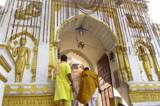NEWS
 22.07.2015
22.07.2015 North-East India February, 1, 2015, Giwahati, Assam, Students of Hindi group and teachers of RSUH and MSU visited Hajo and Powa-Mecca.
Hajo is an ancient holy places particularly for three communities such as Buddhists, Hindus and Muslims. Brahmaputra, the biggest river of India touches the city and next big city Guwahati is located at only distance of 24 kms. The temple Hayagriva Madhava (Lord Vishnu temple) is famous in Hajo. Another temple of Lord Ganesha was constructed by the Ruler Pramatta Singha in year 1744. Few more shrines of Hajo are Shiva temple and Kedareswara Temple built during the ruling period of Rajeswar Singha.Hayagriva Madhava Temple:
the present temple structure was constructed by the King Raghudeva Narayan in 1583. According to some historians the King of Pala dynasty constructed it in 6th century. It is a stone temple and it enshrines an image of Hayagriva Madhava. Some Buddhists believe that the Hayagriva Mahhava temple, best known in the group of Hindu temples, is where the Buddha attained Nirvana. At this imposing temple, the presiding deity is worshipped as the Man Lion incarnation of Vishnu by the Hindus. It is a stone temple and it enshrines an image of Hayagriva Madhav. The rows of elephants are seen on the body of the temple and they are fine specimens of Assamese art. There is a big pond known as Madhab Pukhuri near the temple. Doul, Bihu and Janmastami festivals are celebrated every year in the temple. Moreover this temple preaches both Hinduism and Buddhism, which attract Buddhist Monks from far flung places. Sayani, the first wife of Kalia Bhomora Borphukan donated a family of paiks and also a plot of land for their maintenance to the Hayagriva Madhava temple during the reign of Ahom king Kamaleswar Singha.
Powa-Mecca:
The masjid known as Powa-Mecca is one more attraction for visitors. This muslim temple is constructed just near the Madhava so travelers did not have to travel for longer to reach the spot. This mosque was constructed in 1657 by Mir Lutufullah-i-Shiraji. The Mughal ruler Shahjahan gave the permission to Shiraji for construction of Mecca. Once tourist reaches Mecca they can also visit the grave of Gyasuddin Aulia located near the Mecca wall.
More about it - http://www.indiantouristspot.com/hajo.html
|
|








